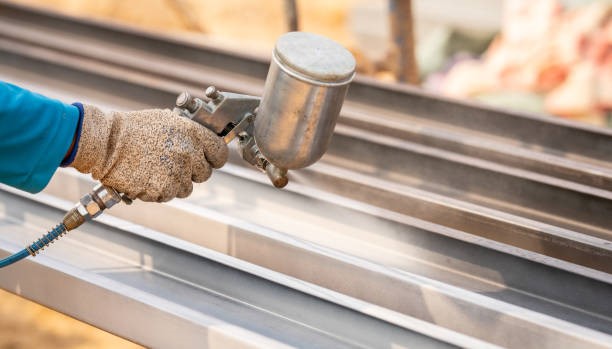In industrial construction, metal components are constantly exposed to harsh environments, ranging from moisture and chemicals to heavy mechanical wear. Over time, these conditions can cause severe deterioration if proper protection isn’t in place.
One of the most effective ways to protect these materials is by applying the right coatings for metal. Doing so helps preserve structural integrity and minimize maintenance needs. Here are the various types of coatings and their common applications.
1. Powder Coating for Metal Surface
This is a dry finishing process in which a powder (usually polyester or epoxy-based) is electrostatically applied to a metal surface. It is then cured under heat to form a protective skin. This method is popular for its resistance to chipping, scratching, and fading, and allows for a wide variety of finishes and colors. Powder coating is widely used on everything from appliances to automotive parts, and it provides both aesthetic and protective benefits.
2. Galvanizing Process
Coating steel with a layer of zinc creates a protective barrier that helps prevent corrosion, a technique commonly known as galvanizing. The most typical form is hot-dip galvanizing, where the metal is dipped into molten zinc. There’s also electro-galvanizing, a more controlled process using electric current. Due to their cost-effectiveness and excellent corrosion resistance, galvanized coatings are standard in construction materials, fencing, and roofing.
3. Anodizing Process
An electrochemical process, anodizing, is primarily used for aluminum. It helps thicken the natural oxide layer on the metal’s surface, increasing corrosion resistance and allowing for vibrant, long-lasting color finishes. Thanks to its aesthetic appeal and enhanced durability, anodized aluminum is used in electronics, cookware, architecture, and more.
4. Electroplating Finish
Electroplating refers to a process that utilizes an electric current in applying a thin layer of metal, like nickel, chromium, or gold, onto the surface of a different metal. This technique enhances visual appeal, increases corrosion resistance, and helps minimize friction. It is also popular in electronics and automotive applications where both appearance and function matter.
5. E-Coating
Electrophoretic coating, or e-coating, involves submerging a metal part into a water-based solution and applying an electrical charge to attract paint particles. The result is an even, durable, and corrosion-resistant coating. It’s ideal for complex metal parts and is often used in automotive manufacturing and home appliances.
6. Thermal Spray Coatings
These coatings are applied by spraying melted or heated materials, like metal or ceramic, onto a surface. They provide excellent wear and corrosion resistance, which is ideal for high-stress environments. They are frequently used in aerospace, marine, and industrial equipment applications.
Protect Your Structures with the Right Coating Solutions
Choosing the right coatings for metal ensures long-term durability, resistance to environmental damage, and enhanced aesthetics. Whether you’re working with outdoor structures, industrial equipment, or decorative pieces, understanding your coating options empowers you to make the best decision for your needs.
For expert advice and high-quality coating and other construction solutions, contact the specialists at I&I Soft Craft Solutions today.

